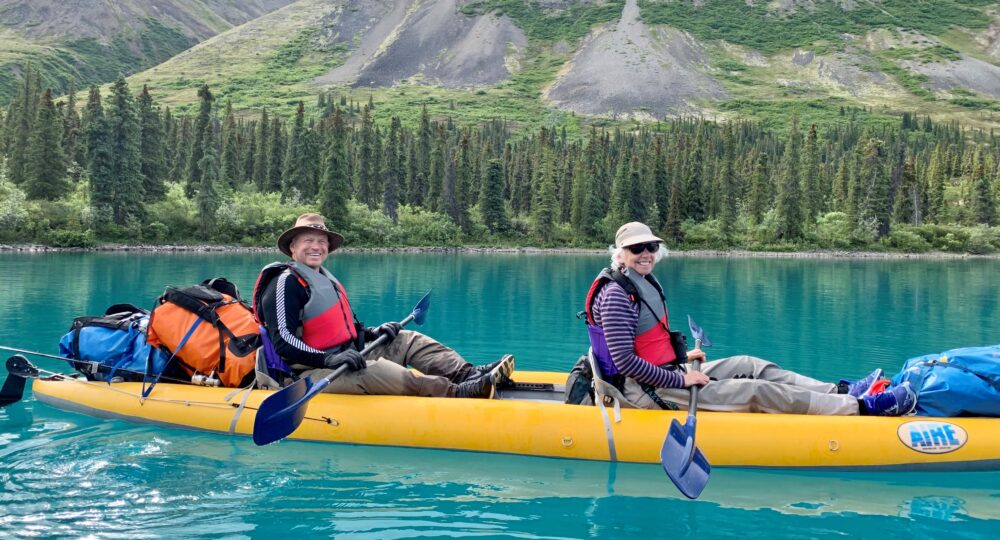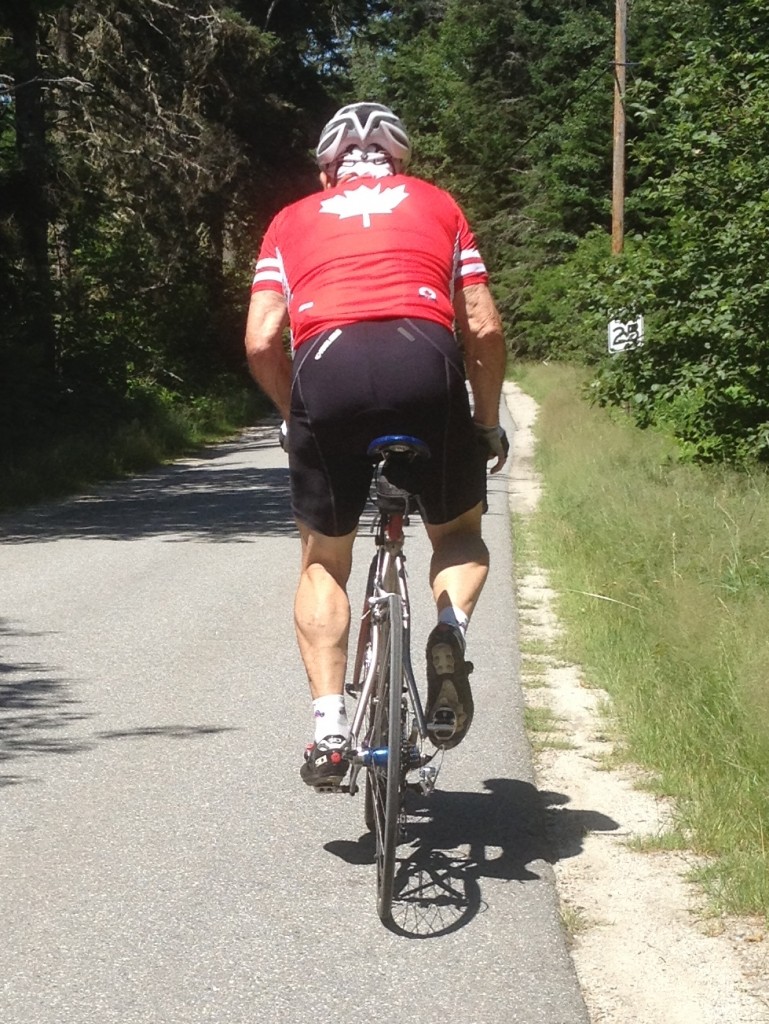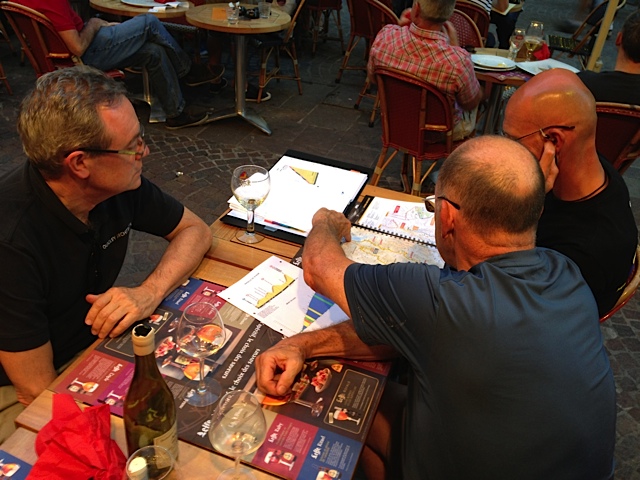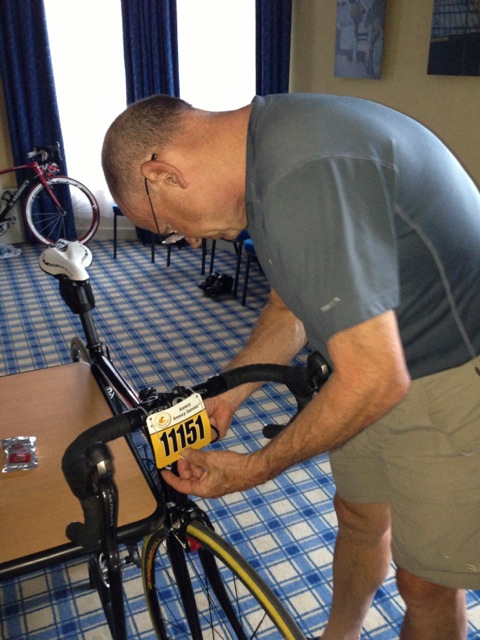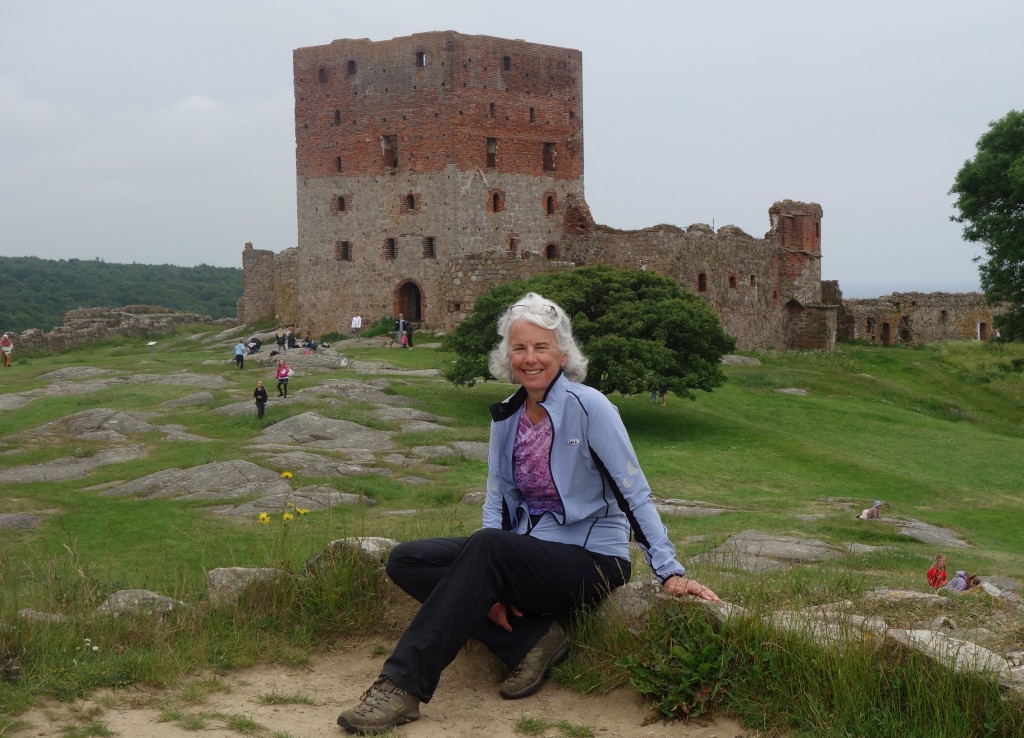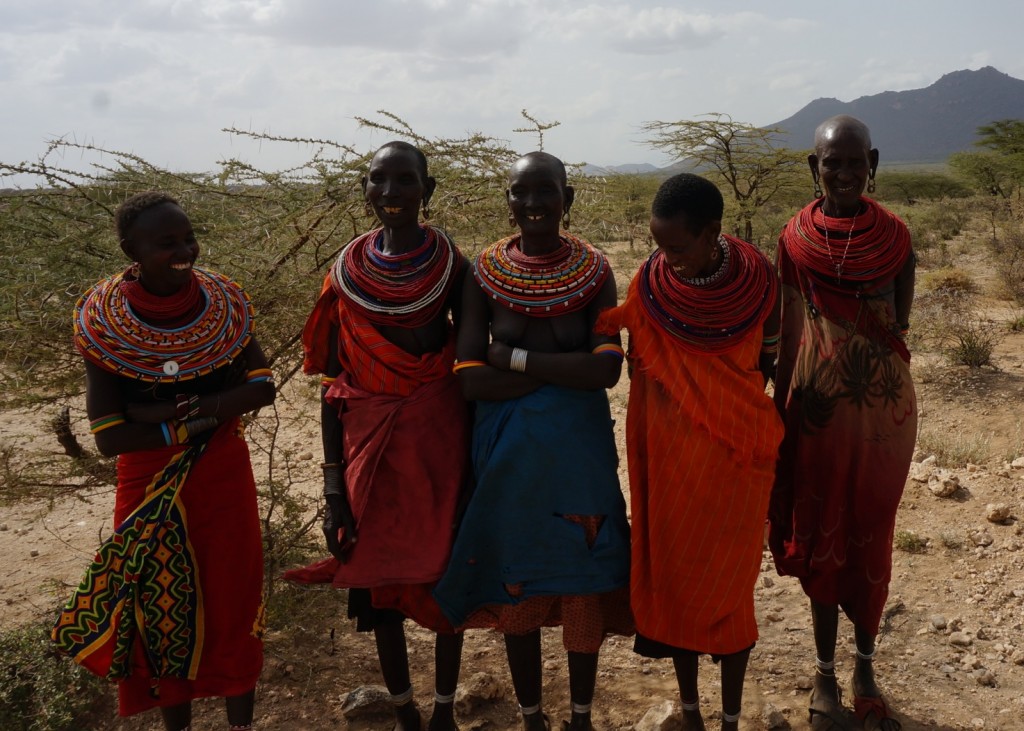I love
John’s legs,
Pumping pedals up and down.
Strong, sculpted, serviceable
Like David.
As perfectly proportioned
As the Vitruvius Man.
No mere hamstrings these
Sinuous forms moving under taught skin and lycra.
Semitendinosus, semimembranosus,
Vastus lateralis, biceps of the thigh.
The gastrocnemius flexes to display
A great inverted heart
And from the back of calves
Delivers a continual visual valentine.
When rarely I pass, I receive
A full display where quad meets knee of
Rectus femorus, vastus medialius
And vastus lateralis power.
I cannot see the action where hip meets thigh,
My heart flutters,
I can only imagine.
Author Archives: Anne Knapp
Pre-event Preparation
About two days before the Etape, John changed. The gregarious, relaxed guy I usually live with disappeared, replaced by a pensive, brooding, pacing, sometimes growling tiger. My space, like Piscene Patel’s (Pi in “The Life of Pi”) was inhabited by a “Richard Parker.”
Fortunately I’ve seen this beast before. The two serious “athletes” in the family — John and Marion — undergo this metamorphosis before every big event, physical or mental. They turn inward, grow silent, scowl and snarl if pulled into the trivialities of every-day life. They are focused on the event, the challenge, the competition and their goals. They are readying for the fight.
I find the process interesting. It isn’t that I’m uncompetitive, anyone who knows me can attest to that. But I am not in John’s — or Marion’s for that matter — league. They have a physical need to “win” and more often than not, they do. What I have learned over the years, though, is that every Richard Parker needs a Pi to perform at his or her best.
Old Friends
In the fall of 1965, Lise Hansen rescued me. I was a large, freakishly tall, pubescent 12-year old American enrolled in a public school in Virum, Denmark; a suburb of Copenhagen. My classmates were all petit — a head shorter than I, their growth spurts yet to come — Danish pre-teens whose English consisted of parroted lyrics from The Beatles and Herman’s Hermits and Level 1 ” Learn to Speak English” textbooks. I was a circus side-show thrust into their midst and the boys, in particular, found taunting me rather amusing. Needless to say, I was not a happy camper; miserable enough that, unbeknownst to me, my parents were considering the extreme and expensive option of putting me in a private American school.
Rites of Passage Redux
We arrived back in Copenhagen from Bornholm on Friday afternoon, June 28th, the day tens of thousands of Danish 19 year olds celebrated their successful “Studenter Exams” and graduation from Gymnasium (high school). On this auspicious day, tradition calls for each student to wear a white, maroon and gold “Studenter hue” (cap) and for each class to pile together in a vehicle and visit the home of every student in the class; partying loudly from beginning to end.
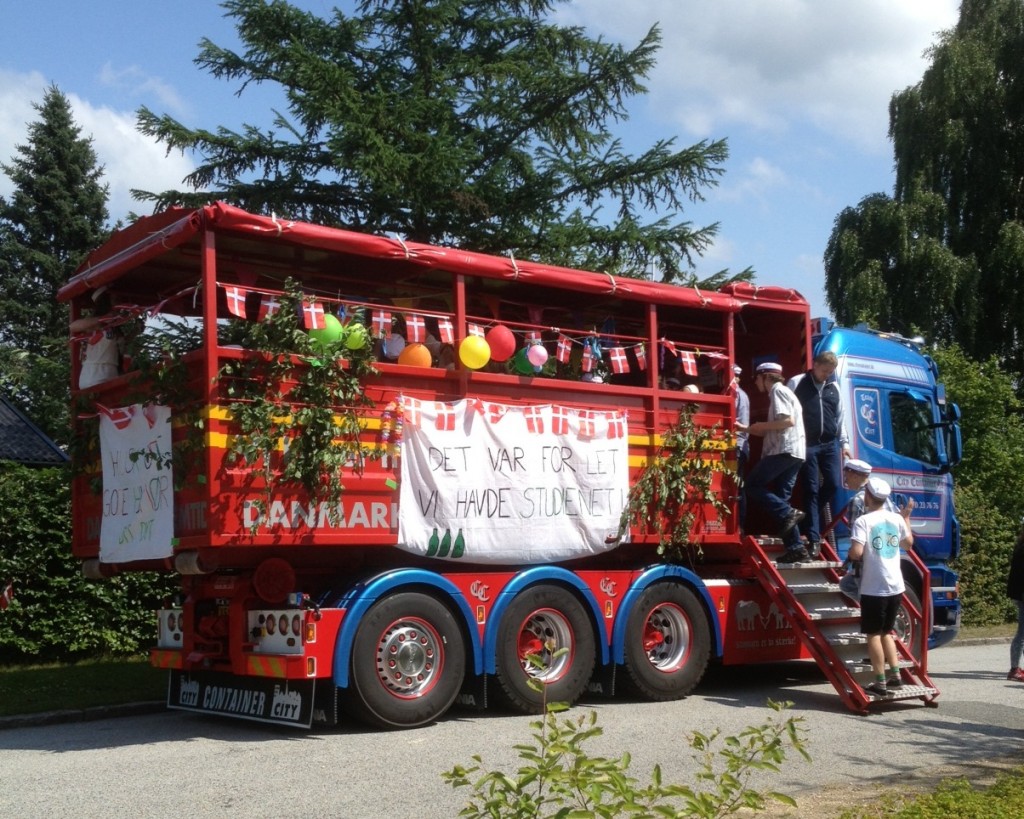
In the olden days, students used horse-drawn carriages. This is the modern conveyance that was parked across the street from Lise and Vincent’s. There were three more in the immediate neighborhood and hundreds more throughout Copenhagen that night.
Continue reading
Biking Bornholm: Is hard fun?
For the past four days we have been biking on the Danish island of Bornholm: a tear-dropped shaped land mass in the Baltic, south of Sweden and smack in the middle of the main shipping lanes in and out of Stockholm, Helsinki, Gdansk and Saint Petersburg. Its rugged coast is unusual for pancake-flat Denmark with cliffs, craggy outcroppings and stone beaches of tide-ground rocks ranging in size from marbles to melons. Smoked herring and granite quarries were once the island’s main industries, but the fish have moved and granite is cheaper elsewhere. Barnholm is now a garden of beautifully tended farms, rolling hills, quaint villages, thousand year-old round churches and Hammershus, the ruins of a medieval castle. Tourists have replaced fishermen and the smokeries (used for smoking herring) have been converted to restaurants, gift shops and art galleries.
Continue reading
Rites of Passage
“Our bead program gives these women dignity and hope,” Celina said, eyes blazing as we discussed NRT Trading’s bead and micro-finance program over a cup of coffee in a Meru café. “Once they reach maturity, the girls are circumcised and married off by their fathers in exchange for cows and goats. They enter homes that are ruled by the men. They are powerless. When they join the bead program we teach them about household finances, about business disciplines and about the outside world. We give them a way to get together with other women to make money and to gossip. What they earn they use to buy food, to help pay the education fees for their children and to earn respect from their husbands.”
OK, hold on a minute, back up: Circumcised? Female genital mutilation (FGM)? I thought that was illegal in Kenya.
M-Pesa, Safaricom, Equity Bank and Cows
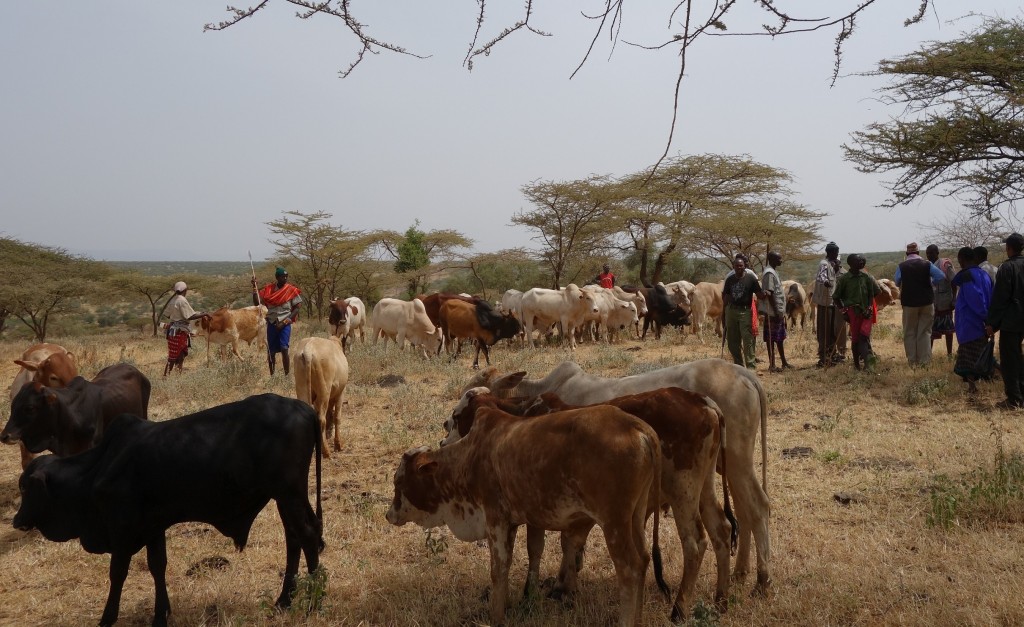
On most of the planet, it is money that makes the world go round. In the pastoralist communities in northern Kenya, it is cows. The region’s future — it’s community health, peace, land conservation and wildlife preservation — depends on bringing these two systems together.
You can’t drive in Kenya without being aware of Safaricom or M-Pesa. Buildings everywhere are painted bright Safaricom or M-Pesa green and emblazoned with the companies’ logos. We quickly figured out that Safaricom is Kenya’s version of AT&T; we now have Safaricom phones and local phone numbers. But M-Pesa? That remained a mystery until we attended a community livestock sale.
Continue reading
A Walk Anyone
I love to walk and here I am in a beautiful, open grass land with miles and miles of red dirt road stretching before me. It looks perfectly peaceful, beckoning even.
“Can’t I just walk the kilometer from Ngiri House to Lewa Headquarters?” I ask Lydia, our server, at breakfast,
She looks puzzled, like I asked a question she didn’t understand. “Walk?”
Continue reading
Getting Acclimated at Lewa
We arrive about 2 pm on Saturday and are shown our thatched roof hut at Ngiri House. Then we are left to our own devices for a day and a half with the keys to a khaki-colored, four wheel drive Toyota Land Cruiser sporting an industrial-sized cattle guard and no instructions other than always close the hut door or the monkeys will get in. Our small semi-circular veranda looks out onto a swamp where we can see large black and white cranes taking off in the distance. The air is filled with the sounds of unfamiliar birds, buzzing insects and monkeys chattering and chasing each other around the lawn and through nearby trees. The place feels deserted and 62,000 hectares stretch out in front of us. What to do?
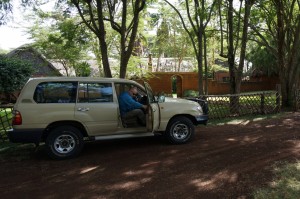
Continue reading
